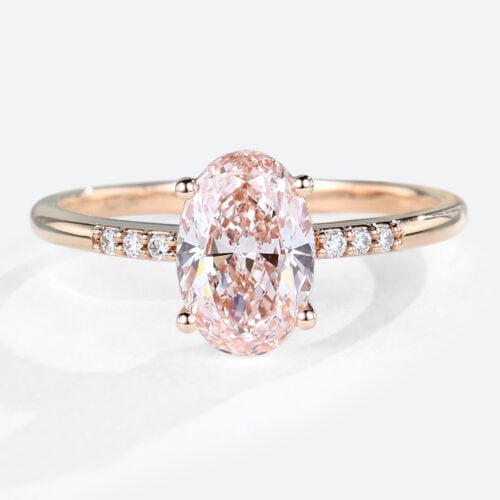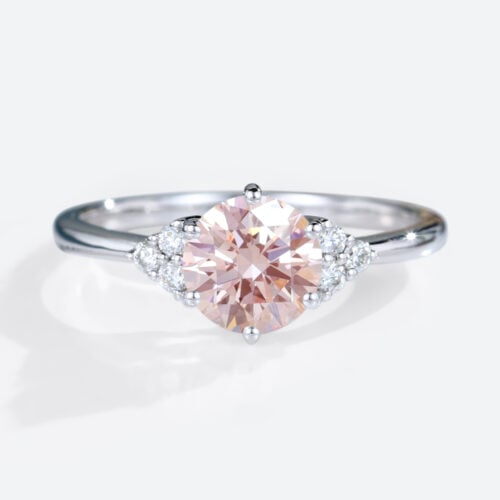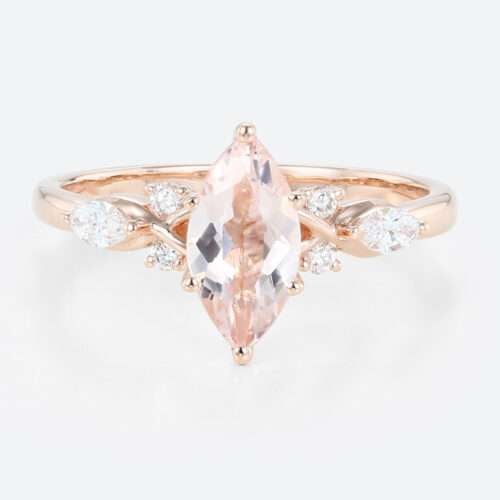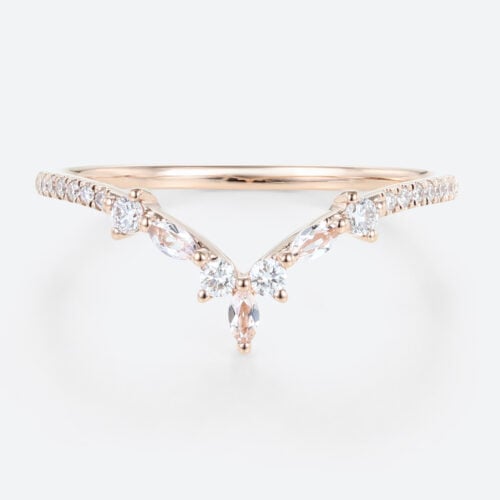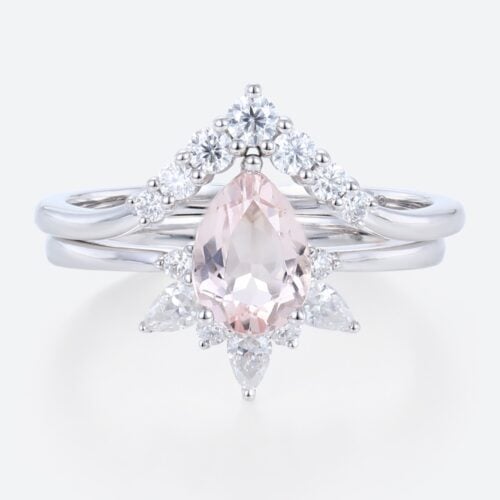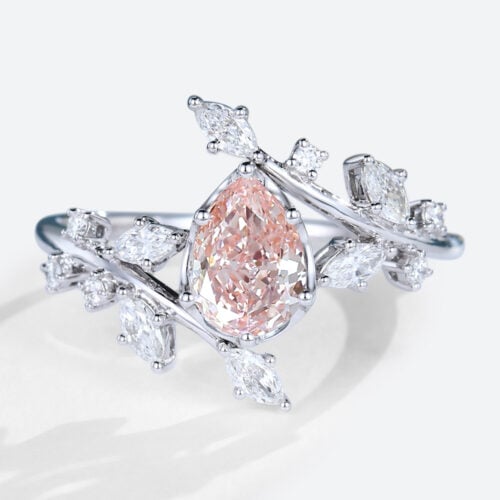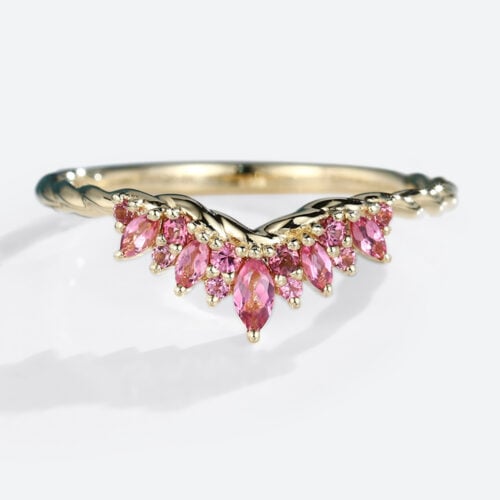Lab-Grown Pink Diamonds vs. Morganite: A Tale of Two Pink Gems
 Danae
DanaeIn the vast and colorful world of gemstones, pink holds a special kind of allure—delicate yet daring, romantic yet modern. It evokes softness and grace, but also carries a quiet strength that has made pink gems a rising star in fine jewelry, particularly in engagement rings and keepsake pieces.
Among the many shades and varieties of pink stones, lab-grown pink diamonds and morganite are two of the most talked-about contenders. At a glance, both offer that coveted blush tone—but beneath the surface, they are vastly different in origin, composition, durability, and meaning.
This article dives deep into what sets these two gems apart—not just in price or color, but in the story they tell, the lifestyle they suit, and the kind of beauty they offer. Whether you’re a gemstone enthusiast, a prospective bride, or someone on the hunt for a meaningful gift, understanding these pink gems will help you choose with both confidence and heart.
I. What Is a Lab-Grown Pink Diamond?
To understand lab-grown pink diamonds, we must first understand what a diamond is—a crystal made entirely of carbon atoms, arranged in a structure so tight and symmetrical that it reflects light like no other material on Earth. Lab-grown diamonds replicate this exact atomic structure. The only difference is where the story begins: not deep beneath the Earth’s crust, but inside a high-tech laboratory that recreates the intense heat and pressure conditions of nature.
There are two main methods of creating lab-grown diamonds:
HPHT (High Pressure High Temperature), which mimics the Earth’s mantle by applying extreme pressure and heat to a carbon source.
CVD (Chemical Vapor Deposition), which grows diamond layer by layer using carbon-rich gas in a vacuum chamber.
To achieve the pink hue, trace elements (like nitrogen or boron) may be introduced during formation, or post-growth treatment may be applied to alter the diamond’s crystal lattice—producing that coveted blush tone that natural pink diamonds are famous for.
II. What Makes Lab-Grown Pink Diamonds Special?
Rarity Made Accessible: Natural pink diamonds are among the rarest gems on Earth, often mined in only a few places like the now-closed Argyle mine in Australia. Their scarcity means that even small stones fetch sky-high prices. Lab-grown versions make this dreamlike color accessible to many more people.
Hardness & Durability: Ranking a perfect 10 on the Mohs scale, lab-grown diamonds share the same unparalleled hardness as mined diamonds. This makes them ideal for daily-wear jewelry like engagement rings and wedding bands, where long-term durability is essential.
Brilliance & Fire: Thanks to their perfect crystal formation, these diamonds are highly refractive—meaning they capture and return light with incredible sparkle. In pink, that fire becomes even more mesmerizing, often showing subtle flashes of violet, peach, or rose.
Color Control: One of the advantages of the lab-grown process is consistency. While natural pink diamonds can vary widely in tone and saturation, lab-created versions allow jewelers to select stones that meet precise aesthetic standards—from the palest ballet pink to rich magenta.
Ethical and Environmental Benefits: Lab-grown diamonds involve no mining, minimal water use, and a dramatically smaller carbon footprint compared to traditional diamond extraction. They’re also free from the human rights concerns that can accompany conflict diamonds.
In short, lab-grown pink diamonds offer an extraordinary blend of science, sustainability, and sparkle. They are the pink gem for the woman who wants a touch of fantasy—without compromising on strength, ethics, or brilliance.
III. What Is Morganite?
While lab-grown pink diamonds are a marvel of modern science, morganite is a gift of the Earth—an organic creation formed over millions of years beneath the planet’s surface. It belongs to the beryl family of gemstones, the same group that includes emeralds and aquamarines. What sets morganite apart is its distinct peach-pink to blush-rose coloration, which owes its charm to trace amounts of manganese in its crystal structure.
First discovered in Madagascar in the early 20th century, the gem was named “morganite” in honor of financier and gem collector J.P. Morgan—an avid patron of the arts and sciences. Since then, it has grown in popularity not only for its romantic hue but also for its gentle glow, feminine energy, and symbolic depth.
IV. What Makes Morganite So Loved?
A Naturally Romantic Hue: Morganite’s color palette ranges from pale ballet pink to soft peach and even delicate salmon. Unlike the saturated, vivid tone of pink diamonds, morganite exudes a more ethereal, watercolor-like beauty. Its subtlety is often associated with grace, compassion, and emotional healing—a reason it’s become a favorite stone in bridal jewelry.
Luminous Clarity and Sparkle: Morganite has a vitreous (glass-like) luster and tends to be quite clear, especially when well-cut. Though it doesn't have the fiery brilliance of a diamond, it offers a soft, glowing sparkle that many find dreamy and romantic rather than dazzling.
A Meaningful Symbol: In crystal lore and metaphysical circles, morganite is associated with love, healing, and divine connection. It’s often given as a symbol of tenderness, renewal, or a gentle new beginning, making it a perfect gift for engagements, anniversaries, or milestones.
Hardness and Wearability: With a Mohs hardness of 7.5 to 8. morganite is durable enough for regular wear—especially in earrings, pendants, or carefully set rings—but it's softer than diamonds and can scratch or chip more easily. That said, with proper care and thoughtful settings (like protective bezels), it can remain beautiful for decades.
Size and Affordability: One of morganite’s most attractive qualities is its size-to-cost ratio. You can get a much larger morganite for the same price as a small diamond, making it ideal for statement pieces or those who crave that luxury look on a more accessible budget.
Unique Appeal: Because it's a natural stone with subtle internal patterns (called “inclusions”), no two morganites are exactly alike. This gives each gem a sense of individuality and organic charm—something that speaks to wearers who value natural beauty over engineered perfection.
In essence, morganite is the choice for those drawn to softness over spectacle, meaning over material, and nature over lab-born precision. It’s not the gemstone for everyone—but for many, it’s exactly what makes it feel personal, intentional, and full of heart.
V. Visual Comparison: Which Shade of Pink Speaks to You?
When it comes to pink gemstones, it’s not just about the color—it’s about what that color feels like. The choice between a lab-created pink diamond and a morganite gemstone is often a matter of emotion as much as aesthetics. Let’s take a closer look at how each one expresses its beauty through real-life jewelry designs.
Lab-Grown Pink Diamond Rings: Bold, Brilliant, and Contemporary
In the first set of images, the lab pink diamonds take center stage in highly polished, high-impact settings. Whether in princess, pear, oval, or round cuts, these gems dazzle with their fire and precision.
Color: These diamonds exhibit a vibrant blush-to-rosé tone, with a crystalline sharpness that feels almost futuristic. The pink is bright, confident, and even a little regal—like a champagne toast at a gala.
Setting Style: Many of the rings feature clustered diamond halos, sharp symmetry, and sculptural curves. This speaks to a more modern glamour—ideal for someone who loves statement pieces, red carpet flair, and luxurious details.
Metal Choices: From warm rose gold to sleek white gold, the contrast enhances the diamond’s pink intensity, while the clarity of the stones ensures maximum sparkle from every angle.
These pieces are undeniably dramatic, ideal for someone who wants to wear their confidence—and their sparkle—on their finger.
Morganite Rings: Ethereal, Romantic, and Naturally Graceful
The second collection offers a softer, dreamier experience. The morganite rings lean into delicate warmth and fluid, organic lines. You’ll see lots of marquise and pear shapes, nested in elegant settings that highlight—not overpower—the gem.
Color: Morganite’s palette is more sunset than spotlight—think blush champagne, soft peach, and translucent rose. This subtlety gives it an almost vintage charm that’s ideal for lovers of timeless elegance and gentle romance.
Design Aesthetic: The settings feel more whimsical and feminine, often with curved bands, marquise-cut side stones, and gentle clustering. There’s a hand-crafted intimacy to these pieces that gives them a sense of story, not just sparkle.
Affordability: With prices starting under $200. morganite rings offer approachable luxury. You get a sizable center stone, a beautiful setting, and a feeling of sophistication—without a high price tag.
These are rings that whisper instead of shout. They don’t need to sparkle the loudest to be unforgettable.
VI. Which Pink Gem Is Right for You?
In the end, the choice between a lab-grown pink diamond and morganite isn’t about which is “better”—it’s about what speaks to you.
If you’re drawn to vivid brilliance, high durability, and a gemstone that turns heads with its sparkle, lab pink diamonds are a modern marvel that won’t disappoint. They're perfect for someone who wants the elegance of a diamond with a contemporary twist—and they carry the emotional weight of luxury, love, and forever.
On the other hand, if your heart leans toward soft elegance, warm romance, and understated beauty, morganite may be your gemstone soulmate. With its gentle glow and vintage appeal, it captures the kind of timeless love found in classic love stories.
Both gems celebrate pink in their own unique way—and both can make stunning centerpieces for the moments that matter most.
Still can’t decide? Browse our full collection of Lab Pink Diamond Rings and Morganite Rings at LisaJewelryUS to see what catches your eye. Let your heart lead the way—you might be surprised which one you fall in love with.
Subscribe to my newsletter
Read articles from Danae directly inside your inbox. Subscribe to the newsletter, and don't miss out.
Written by

